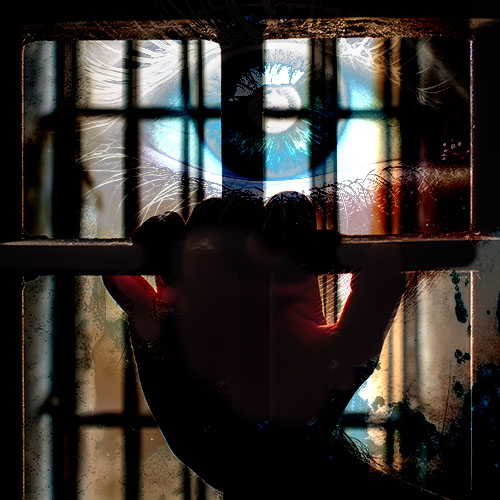Vincent “the Chin” Gigante was the Oddfather, a mob boss who wandered New York’s streets in a tattered bathrobe mumbling that his lawyer was God — and for years, his Oscar-caliber performance kept him out of jail. This is how he did it — and how he fooled some of the top names in forensic psychiatry.
Family Therapy on a Gigante Scale
On the unusually chilly Monday of April 7, 2003, Vincent Gigante shuffled into oak-paneled courtroom of United States District Court Judge I. Leo Glasser in downtown Brookelyn — looking, as usual, like an escapee from One Flew Over the Cuckoo’s Nest. A few days earlier he had turned 75. Here he stood, his usually daffy self. His hair was tousled, his chin covered in white stubble — just another demented senior citizen wearing a Bureau of Prisons navy smock, khaki trousers, and lace-less rubber shoes. For years he’d wandered in and out of courtrooms just like this one, always with the same routine. He’d gaze about as if he’d just arrived from the moons of Jupiter, stare at his lawyer as if the attorney were an alien being, and occasionally focus just long enough to utter non-sequiturs like “God is my lawyer!” or “I don’t know what you’re talking about!”
Today, however, was different. Today was the final performance — the day Chin would admit it had all been just a big joke. It was clear he wasn’t yet used to his new role as a normal guy. When Judge Glasser asked him to raise his right hand to be sworn in, Gigante at first raised his left hand, then corrected himself. When Glasser asked the key question — “You knowingly and intentionally misled doctors evaluating your mental competency?” — Gigante at first began to shake his head no but quickly recovered, nodding and answering, “Yes, Your Honor.”
When it was over, Brooklyn U.S. Attorney Roslynn Mauskopf proclaimed that Gigante’s “legendary charade has finally and conclusively been put to rest” after a mere 13 years of relentless prosecutorial pursuit. Here was a guy whose performance lasted through no fewer than five U.S. attorneys, three sets of assistant U.S. attorneys, and three United States District Court judges. He was first charged in 1990, charged again in 1993, and did not have to face a jury on any of these charges until 1997. Even then, as he was convicted and sent away, he continued the crazy act. To the tabloid-reading public, the question of Gigante’s mental competence remained a mystery even after he was sentenced to 12 years in federal prison.
Gigante, however, apparently had had enough. Within months of being sent away, he dropped the shtick and started having normal conversations with his children, his wife, his mistress, his heart doctor. He did this while in the custody of the United States government, so every banal word ended up on tape. These tapes provided the authorities the smoking gun they’d desired for years, so last year they indicted him again. The prosecutors on the case, Paul Weinstein and Daniel Dorsky, put together a one-and-a-half-hour audio tape that was kind of a greatest hits of Vincent Gigante, Normal Guy. They told Gigante’s lawyers they would happily play every minute of those tapes at trial.
And so Gigante tossed in the bathrobe after more than 30 years of devotion to behaving like a rabid pro se litigant, and U.S. Attorney Mauskopf slipped into noir-speak to declare with a straight face, “The jig is up.” She also took a moment to make fun of all the experts who’d claimed Gigante was clearly insane.
“Although the mental-health experts have literally been fooled by Gigante for decades, law enforcement has always recognized Gigante for what he is: the cunning, powerful, and feared leader of the Genovese organized-crime family,” she said. “Through his guilty plea, there is no further debate.”
But there certainly was an open question. How did a guy who didn’t make it through the ninth grade of public school in New York City fool all those Ivy League experts all those years? How did this guy convince some of the top professionals in the field of forensic psychiatry again and again that he was so insane he couldn’t have placed an order at Mickey D’s without yelping like a hyena?
The answer was simple: consistency.
There is a world of medical literature about “malingering,” the fine art of pretending to be nuts. It is a cottage industry for experts called upon to determine whether a felon is simply trying to get out of jail by claiming to be several cards short of a deck. Usually it’s pretty easy to spot. Most malingerers are not terribly sophisticated. Malingering, after all, is long-term lying. Long-term lying requires stamina and focus. And, most important, consistency.
Most doctors in the field tell tales of bad acting. The average malingerer acts the way he thinks crazy people act; his performance is often based on TV shows and movies about crazy people. He swats at imaginary flies, barks and yips, sings the Barney theme song off-key. Real amateur stuff.
“How do you tell something isn’t genuine?” Dr. Jonas Rappeport, a professor at Johns Hopkins University, tells Penthouse. “Based on your experience. I once had some young man I was seeing in Baltimore. He said, ‘God was talking to me.’ Just the way it was said, something clicked. So I said, ‘Who told you to say that?’ and he said, ‘My lawyer.’”
Rappeport is considered one of the best in his field. He was a founder of the American Academy of Psychiatry and the Law and was the chief medical officer for Baltimore’s Circuit Court. Sometimes juries listened to him; sometimes they did not. In 1982 he testified that John Hinckley Jr. was sane when he shot Ronald Reagan. The jury disagreed. Eight years later Rappeport was brought in by the court to consider the case of Vincent Gigante.
At the time, Gigante had been indicted by federal prosecutors in Brooklyn, who named him as boss of the Genovese family. He had allegedly benefited from a scheme to steal money from taxpayers by shaking down contractors who installed thousands of windows for the New York City Housing Authority. The story came to be known as the “windows case.” When one of the gaggle of doctors hired by Gigante’s lawyers asked Gigante to describe the charges filed against him, the Oddfather replied, “Windows — and they can have my mother’s windows!”
Not surprisingly, all of Gigante’s doctors insisted he was a loon.
In Brooklyn, United States District Court Judge Raymond J. Dearie appointed Rappeport and another doctor, Daniel W. Schwartz, director of psychiatry at the Kings County Hospital in Brooklyn, to provide a more objective measure of the man. Rappeport and Schwartz set to work.
First they reviewed the voluminous medical record, starting with reports of doctors hired by the defense who all claimed Gigante was insane. One dfense psychiatrist, Or. Stanley Portnow, believed Gigante had suffered brain damage from childhood injuries and boxing, and had what he called “a thinking condition of schizophrenic proportions.” Gigante, Portnow declared, had “irreversible mental illness that caused him to be incompetent to stand trial now or in the future.”
Period.
In fact, Rappeport and Schwartz found that no fewer than six clinical psychiatrists had made 34 independent diagnoses of schizophrenia during the 22 times Gigante checked himself into St. Vincent’s Hospital’s psych unit in Westchester County. They read prison hospital records, made notes about all the drugs he’d taken. They viewed tapes of Gigante shuffling in and out of the Triangle Social Club and perused 107 pages of FBI documents summarizing years of surveillance of the Daffy Don. Nothing contradicted the argument that Gigante was mentally incompetent.
Then they interviewed Gigante’s younger brother, a Roman Catholic priest named Father Louis Gigante, and his and Chin’s mother, Yolanda. The mother and brother told the doctors that Gigante had quit public school in the ninth grade and become a laborer, then took up boxing, racking up an impressive 24-1 record. He boxed for five years, got married, and quit. He was a trucker, a janitor, and worked at the annual Italian festivals in the Village. He had five children with his wife, Olympia Grippa, and eventually moved to New Jersey. At the same time, he had a relationship with an Olympia Esposito, with whom he fathered three more children. His family claims he “got sick” in 1966, but wasn’t hospitalized until 1969.
Rappeport and Schwartz looked at the court dockets, starting with the file created by the events of May 2, 1957. That morning, Gigante had walked into the lobby of the Majestic apartment building on Central Park West in Manhattan and become a mob legend. There stood Frank Costello, one of the most high-profile gangsters in America. Gigante — at the time having ballooned to 230 pounds — pulled out a pistol, shouted, “This one’s for you, Frank,” and fired away. The bullet nipped off a bit of Frank’s earlobe, but otherwise did no harm. Gigante took off, and a doorman later described him as “a man with a waddling walk.”
“When Dr. Rappeport suggested Gigante ‘needed and attorney,’ Gigiante replied, ‘God is my attorney.’”
Three months later he surrendered at the West 54th Street station house. “Do you want me in the Costello case?” he asked. He smiled for photographers at his arraignment. He went to trial, and on May 27, 1958, Costello came in as a wit ness and said he hadn’t seen a thing. He added, “I know no human being would have a motive.” Gigante’s mother sat in the front row, fingering her rosary beads. When the acquittal came in after only six hours and 15 minutes, Yolanda wept and shouted, “It was the beads! It was the beads!”
All of this made Gigante an overnight star in the family of Vito Genovese, and when Genovese and Gigante were arrested on heroin-trafficking charges a few years later, Gigante was dubbed by the press “Vito’s No. 1 Boy” before they both went off to jail.
When Gigante came out he got indicted again, but this time Vito’s No. 1 Boy was a sick man. By then he’d been hospitalized at St. Vincent’s a number of times, claiming he was hearing voices. The 1973 indictment alleged he had tried to bribe the entire police department of Old Tappan, New Jersey, where he lived, by sending them Christmas cards stuffed with cash. Gigante told the court-appointed doctors he’d bribed the cops because he feared they believed he was homosexual and that they were coming to get him. These doctors labeled him — in order — “insane,” “psychotic,” “mute,” “schizophrenic,” “a candidate for electroshock treatment,” “infantile,” and “primitive.”
He was acquitted.
From then on, Gigante routinely checked himself into St. Vincent’s for observation. He moved out of his family’s home and in with his mother in Greenwich Village, and went for afternoon strolls in a dirty T-shirt and ratty bathrobe. He stopped bathing and shaving. He wandered Greenwich Village sputtering and muttering, drooling on cue. He would be led down Sullivan Street to the Triangle Social Club, where he’d sit with other men of a certain age whose names appeared on lists down at FBI headquarters. For the agents assigned to watch this spectacle, frustration was the word of the day. Gigante would appear dazed and confused, glancing about as if he were hearing voices that were not there. When the FBI came to arrest him in 1990, he stood in the shower of his mother’s apartment in his clothes, holding an umbrella.
This was the record Rappeport and Schwartz faced as they prepared to determine Gigante’s competency. But all of this was mere background noise compared to the main event: meeting with Gigante himself.
Four sessions totaling nine hours took place in January and February 1991. Three were in New York City prison hospitals; one was inside the apartment of Gigante’s mother on LaGuardia Place in his childhood neighborhood of Greenwich Village. At the hospitals, Gigante was subjected to tests specifically designed to detect malingering, and he was most uncooperative. At home, the doctors hoped he’d open up.
On the cold day of January 27, 1991, Rappeport and Schwartz trudged up to apartment 7E, a tiny, cramped place with lots of pictures of Jesus on the walls. Gigante wore plaid pajamas for the special visit. Gigante’s mother and his priest brother stayed a moment, then left the doctors and Gigante alone.
“We sat at the diningroom table,” says Rappeport. “He’s mumbling to himself, looking down. You start to ask him questions — ‘Who’s your attorney?’ — ‘I don’t need an attorney. God is my attorney.’ And it was consistent. It’s very consistent with a delusional system. They stick to it.”
In their reports, both Rappeport and Schwartz wrote that Gigante could remember the proper names of his medicine and the name of the president, the governor, and the mayor of New York. But he couldn’t remember how to spell his own name. He talked “plainly, slowly, and simply, without profanity,” but he seemed almost sleepy. Sometimes he answered questicms with nonsense. He repeatedly asked the doctors who they were. He sometimes mumbled. When he spoke, he did so mostly without emotion. His affect was flat, although he tried a little joke. Rappeport asked him to spell world backwards; Gigante looked perplexed and, after a long wait, replied, “We’ll be here all day.”
Overall he was uncooperative. He kept repeating, “God told me not to answer,” so Rappeport interjected, “You need an attorney real bad.” Gigante jumped up and left the room. Rappeport followed him into the hall and asked him why he was upset. Gigante replied that the doctor had called him a liar. Rappeport said he had not, that he had merely suggested Gigante was “in serious difficulty and needed an attorney badly.” Gigante replied, “God is my attorney.”
Rappeport also noted a tremor in Gigante’s leg. In a 1971 report, a doctor who’d examined Gigante during his police-bribery indictment noted that Gigante had a tremor in his leg. That doctor, way back in 1971, had also noted that Gigante seemed drowsy during the interview and at one point jumped up and walked out of the room.
Rappeport wrote in all caps, “What is of particular importance here is that Mr. Gigante’s behavior in 1971 was almost identical with his behavior in 1991.” Gigante’s condition, Rappeport declared, “is unlikely to improve with further psychiatric treatment, even inpatient treatment, within a reasonable period of time. I consider his condition to be permanent.”
Dr. Schwartz suspected malingering, noting that on occasion Gigante would drop the mumbling God-obsessed blather and actually answer a question. When asked why he was there being examined by doctors, Gigante paused and answered, “I wish I knew.” Nevertheless, Schwartz declared that Gigante suffered from what he called a “psychotic disorder not otherwise specified” and that he “lacks substantial capacity to understand the charges against him and assist in his defense.”
With both the defense doctors and the court’s doctors agreeing that Gigante was insane, the alleged ruler of the Genovese crime family was declared unfit to proceed, and the indictment was, in effect, put into a state of suspended animation.
Feds never give up.
Gigante was indicted again in 1993, and a new troop of doctors now entered the scene, including Rappeport and Schwartz. Once again various doctors weighed in, all with the same conclusion. Prosecution and defense doctors still found him to be mentally incompetent, with one describing him as a child-like man who refused to shower and who claimed his only enjoyment was watching cartoons featuring martians.
On May 15, 1996, Brooklyn Federal Judge Eugene Nickerson had had enough. The case had languished on his docket for six years, and Gigante was still living with his mother. Nickerson basically ignored all the doctors and declared Chin competent to stand trial, writing that Gigante’s ruse was “an elaborate deception” with a clear motive: “to avoid apprehension by law enforcement.” Nickerson set a trial for the following year.
The circus began on June 25, 1997. Before trial, the new judge assigned to the case, Jack Weinstein, had ordered Gigante to be clean-shaven and properly dressed. On opening day Gigante was rolled in in a wheelchair with several days’ growth of beard and dirty undershirt exposed. The judge was furious. After that, Gigante showed up clean-shaven in a blue blazer.
During the trial he got a daily blood-pressure check. He was popping thorazine, sitting at the defense table looking dazed, his lips moving but no words being uttered. Prosecutors Andrew Weissman and George Stamboulidis brought in gangster after gangster to say they’d had lucid talks with the man about mob business. Mostly the testimony was old or second- or even third-hand. Salvatore “Sammy the Bull” Gravano, the former Gambino underboss turned star informant, claimed he talked mob business with Gigante four times, but the last time was 1988. He admitted he thought Gigante might in fact be crazy, but insisted that as far as he was concerned, Gigante was the boss of the Genovese family.
Only Pete Savino, a 54-year-old Genovese associate, got to the heart of the matter. Sitting in a wheelchair and wiping sweat from his drawn face, the gravely ill Savino testified by video. He was dying of cancer somewhere out there in the American night, but he got it together long enough to state that in 1987 he was summoned to the Triangle Social Club. He said under oath that Gigante took him into a bathroom, turned up the faucets full blast, and whispered into his ear. “He wanted to know if I was paying the Irish guys,” Savino said, referring to union officials involved in bid rigging. Savino testified that Gigante then whispered, “’Don’t be afraid to tell people I’m crazy, because you know I’m crazy, right?’ And I said, ‘Yes, I know you are.’”
On July 25, 1997, Gigante was convicted of racketeering and conspiracy to commit three murders, but not murder. After three days of deliberation, the jurors had concluded that Gigante was sane enough to plot the murders of John Gatti and his brother Gene, as well as Pete Savino. He was also convicted of extortion and union-payoff conspiracies in the “windows” bid-rigging scheme, activities that require some mental agility. He was 69. He looked straight ahead and rolled his eyes toward the jury box. His daughters and granddaughters sobbed. Outside court, his heart doctor, Bernard Wechsler, told reporters, “He doesn’t know what’s going on. He had no reaction. People are crying all around him, and he doesn’t know what’s happening.” One of his lawyers, Steven Kartagener, said Gigante was mentally incompetent and couldn’t assist in his defense. Prosecutor Stamboulidis said, “His criminal charade is over.”
Still the act continued. At a presentence hearing in December 1997, four doctors (two appointed by the court; two hired by the defense team) said again that Chin — newly convicted of racketeering — was still incompetent. This time, though, two government doctors said he was competent. The federal prison doctors where Gigante was being held in North Carolina split the difference, declaring that Gigante was probably suffering from dementia, but was also likely malingering psychosis.
“‘I Think the man does deserve an Oscar,’ says Dr. Van Gorp about Gigante. ‘This man, in his field, is the best.’”
On December 18, 1997, Judge Weinstein quoted As You Like It: “And one man in his time plays many parts…. Last scene of all, that ends this strange eventful history, is second childishness.” He then sentenced Chin to 12 years in prison, stating, “He is a shadow of his former self, an old man finally brought to bay in his declining years after decades of vicious criminal tyranny.” Naturally Chin had shown up in sweatpants, but was given gray slacks by the judge to go with his navy blazer and blue polo shirt. He appeared frail and confused, unsteadily grasping the side of the table. Afterwards one of his lawyers said Gigante asked him, “What’s going on? What do they want?”
And then the Chin went away.
The father calls his daughter at 10:29 P.M. two weeks before Christmas 2000.
His voice is raspy with age, but he is obviously happy to chat with his little girl. She answers, “Daddy?” and he warmly responds, “Baby!” Pleasantries are exchanged. He complains about his health, but he’s entitled. He’s 72. Sometimes he’s a little hard of hearing. They discuss weather; there’s a bad ice storm where he is in Texas.
“It’s raining and it’s turning to ice,” he says. “How do you feel?”
“I’m okay,” she says. “It’s cold here.”
He asks about “Mommy” and his other children. He yawns. He wants to know what they ate for dinner and hear about all the people shopping before Christmas. When she asks if he has gloves for the cold, he says yes but she doesn’t believe Him. She says she hopes to see those gloves when she comes to visit.
“All right,” he says. “I hope I don’t have to wear them. I hope it’s warm.”
“I hope it’s hot while I come and see you,”’ she responds. “Seventy degrees.”
“Oh, Cammy,” he says, calling her by her pet name. “You’re the best.”
“Love you, Popsicle,” she says.
It is all so incredibly mundane, so banal — so painfully normal. Then a mechanical voice interrupts: “This call is from a federal prison.”
The father is Inmate No. 26071-087, Vincent “the Chin” Gigante, boss of the nation’s most powerful Mafia organization, the Genovese crime family, calling from the Federal Medical Center in Fort Worth. The same Vincent Gigante who for years insisted he was incapable of running a washing machine, much less a secret organization that rakes in millions in illicit profits. This is the same Vincent Gigante who wandered the streets of Greenwich Village jabbering like a chipmunk and twitching like a sparrow. The Oddfather. The Robe. The Daffy Don. Or, as his daughter put it, “Popsicle.”
On the tape he is not babbling that God is his lawyer or drooling into the receiver. Instead, he is delighted about absolutely nothing of consequence. When he says goodbye to his daughter Camella, she puts her mother, Olympia Esposito, on the line. Esposito is Gigante’s common-law wife. They proceed to chat in excruciating detail about his many medical complaints, with Gigante reeling off medical terms like an intern. He discusses one of his doctors’ opinions about his health with an extraordinary memory for detail.
“He says, you know, your ejection, we done the echocardiogram there,” says the man deemed so feeble he supposedly can’t remember his children’s names. “Your ejection fraction is down to 35. Normal is 60.”
“So?” says Olympia.
All of the tapes are like this. Gigante has lost the flat affect and speaks with emotion to family members, who have obviously participated in this folderol for years. He makes jokes. He remembers what he ate for lunch. He carefully tracks the number of hours the prison allows him to chat on the phone per month and corrects his children about the time left. He makes fun of a fellow inmate who makes noise while he’s on the phone.
“You got a big mouth,” he says to the man. “Nut. That guy’s name is Benzene-Head. He’s nuts. He’s always hollering. They whistle and they holler.”
When he learns on April 30, 2001, that he and several members of the Genovese crime family have been indicted, he presses for details.
“They says I’ m indicted on something …. They indicted me?”
Olympia Esposito says, “Some men were arrested, they said that they were from a certain family, and that you were running it from Texas.”
“I’m running it? I’m running around the park.”
“Yeah, I know,” Olympia says.
“I’m sick. Well, you know,” Gigante says. “It don’t bother me. I talk to God. God takes care of me.”
Early on the terrible morning of September 11, 2001, Gigante was the one who let his children know what was happening.
“What’s happening over there?”
“Nothing, Dad,” says one of his sons, Vincent Esposito.
“Everybody says there’s plane crashes over there. In New York. The Trade Center, Washington, D.C., all over, they say.”
“Plane crashes?”
“The terrorists, they said … That’s what I’m worried about. They just come and tell me that it crashed into the Pentagon, I don’t know, in Washing ton, D.C. A plane went through the Pentagon.”
The guy who supposedly can’t shave himself says, “Put the news on. See what’s going on.”
He makes fun of himself. In an 11:14 P.M. call to Olympia Esposito on Christmas night 2000, he is worried about his daughter Yolanda, who is having medical problems.
“She can’t talk,” Gigante says. “I don’t know. It’s something, she lost her voice. I said, ‘You got like me’ “-and then he mumbles in his old bathrobe-in-the-park manner.
Much of the chatter is sad. On July 4, 2001, he is about to say good-bye to Esposito around 10:35 P.M. when he asks, “Are they shooting fireworks?”
“They did it,” she says. “It’s raining now.”
“It’s raining there?”
“Yeah, it’s like right after the fireworks, it came down in buckets.”
“Okay,” he says, and then he says good night.
He wants to know every little detail. He wants to know what it’s like to be out there doing normal things with other normal people.
“I think the man does deserve an Oscar,” Dr. Wilfred Van Gorp tells Penthouse. “This man, in his field, he’s the best.”
Van Gorp, professor of clinical psychology and director of neuropsychology at Columbia University’s Department of Psychiatry, is one of more than a dozen experts who had over the years declared that Chin Gigante was certifiably insane. Van Gorp was one of the six psychiatrists who examined Gigante during the 1997 trial and declared him thoroughly unfit to stand trial.
At the time he wrote that Gigante “currently has moderate to severe dementia which reflects significant underlying central-nervous-system dysfunction.”
When Van Gorp issued his report and testified, he was quite sure that at the very least the Oddfather suffered from dementia. He’d interviewed Gigante five to ten times over the years, certifying several times that Gigante was incompetent to stand trial. He had looked at everything: reams of medical files, numerous tests, transcripts of interviews with other doctors. He once went to the home of Olympia Esposito. Gigante muttered and sputtered and did his usual shtick. Van Gorp was skeptical, but he believed the medical tests empirically demonstrated a septuagenarian suffering from dementia — a biological phenomenon, not emotional.
Then in March 2002, after Gigante was indicted again, this time for lying about his mental illness, Assistant United States Attorney Dan Dorsky called Dr. Van Gorp, claiming to have rock-solid proof that the crazy act was a scam. He summoned Van Gorp to his office in Brooklyn across the street from where Gigante had been convicted. The prosecutor popped in a cassette tape and sat back.
Gigante’s voice on the telephone filled the room. The content of the discourse was trivial, but the impact of the words was profound. After an hour and a half, Dorsky turned off the tape.
“It’s phenomenal,” Van Gorp remembers thinking. “The guy is as normal as you and me. The guy is completely normal. He quotes his blood pressure accurately, the exact numbers. He quotes esoterica of his cardiac function. He talks about the· ejection fraction. I don’t even know what that means. But Gigante recalled it. He talks about what he had for different meals. Dorsky even got the menus. [Gigante’s] got amazing memory. He talks about the doctor gave him 40 pills to take. Dan has the doctor’s note saying four times a day for ten days. Every nuance of his regimen. It’s flawless. It’s amazing.”
Van Gorp reviewed his notes to make sure he wasn’t hearing things. The acting was extraordinary. Like Rappeport, he too noticed the shaking-leg trick. He even saw an unusual pronunciation phenomenon that he believed was Gigante’s greatest inspiration: He had been asking Gigante to identify items in certain pictures, and Gigante was doing pretty well. Then he got to pretzel. “Fretzel,” Gigante said. And he repeated it. Consistency.
“I think this is the world’s greatest malingerer,” Van Gorp says. “Tell me another one who’s better. Until I heard this hour and a half, I still thought maybe he has the brain illness and he hammed it up. But I heard these tapes and I knew: This is a normal person.”
Dorsky played the tapes for three other experts, all of whom were blown away. Even Dr. Rappeport, who’d repeatedly found Gigante to be mentally incompetent, heard the true voice of Gigante and found himself questioning everything that had come before. “Maybe he duped us. I find it hard to believe. I’m not infallible,” Rappeport says. But he had a legitimate question that goes to the heart of what Gigante had accomplished. Sure he’d fooled the experts. Sure he’d stayed out of jail. But at what cost?
“I don’t know what the stakes are, but they sure don’t look too wonderful to me, living in that apartment in the Village, a first-generation apartment,” says Rappeport. “He never lived high, he never lived great. Yes, he had his girlfriend, but beyond that there were no trappings of any kind. There was no evidence that anyone could come up with that this guy was living it up. He spends two months every year in a mental institution and he’s walking around in a bathrobe.
“The bottom line is, who’s he kidding now?” Rappeport says. “Maybe he’s still kidding.”
When Gigante finished up his plea in April and headed for the antechamber next to the court, resigned to finishing out the remainder of his sentence, the absurdity of his situation became clear. Here stood the feared boss of the Genovese crime family, a man who could give life or take it away. As he was leaving to go back to prison, he came face to face with one of his subordinates: Liborio “Barney” Bellomo, one of a handful of top Genovese gangsters who had, for a time, served as street boss for the Genovese family to cover for Chin’s act.
As the newly normal Chin headed for the door, Bellomo looked right at his former boss, a man whose name he was never supposed to utter under any circumstance, or face death. But, as the prosecutor had said, the jig was up, so none of that seemed to matter anymore. Which was why Bellomo let down his guard, if just for a moment, with a tiny gesture that spoke volumes about the success of Gigante’s act.
He gave Gigante a little wink.
Of course pulling off an insanity act these days would be much tougher, as most people would simply believe you to be a member of Congress. Although he eventually did die in prison — the same one where John Gotti left this world, oddly enough — Vincent Gigante lives on. We know this becaus for four bucks you can get his trading card.
























